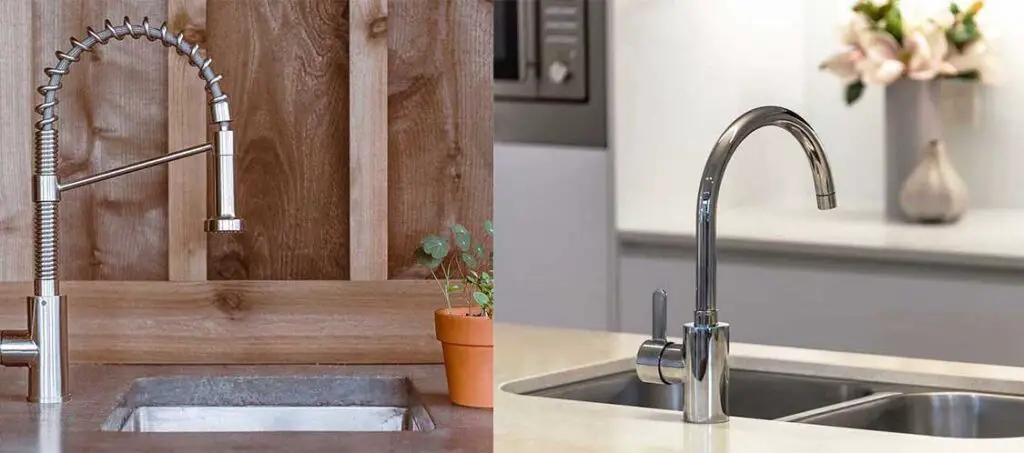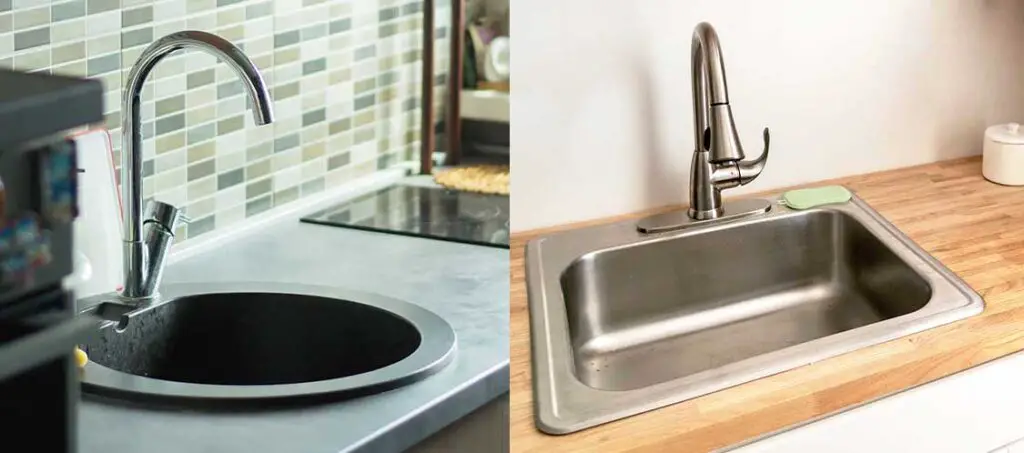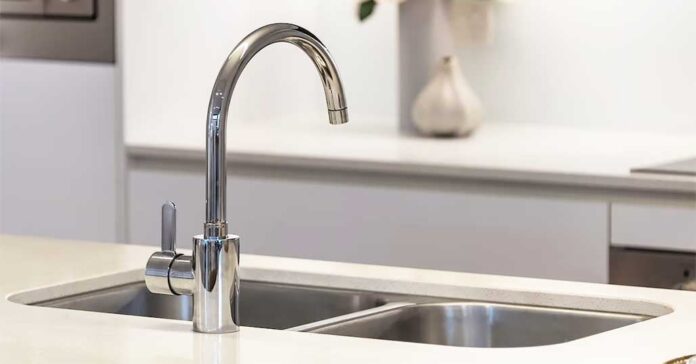Looking to get a new kitchen sink or upgrade your existing one? Not sure whether to go for a undermount or drop-in sink? Here we will break down the pros and cons of each option, as well as touch a few other topics that are very much important when choosing between an undermount and overlay sink. This way, you’ll be able to easily choose the best option for your kitchen. Read on!
- Undermount Sinks
- Drop-In Sinks
- Ease of Cleaning & Maintenance
- Undermount Sink vs. an Drop-In Sink – Things To Consider
- So, Which One Is Better For Your Kitchen?
You might also like: 10 Popular Kitchen Countertop Materials – Pros & Cons
This web portal is supported by its readers, and is a part of the Amazon Services LLC Associates Program and the eBay Partner Network. When you buy using links on our site, we may earn an affiliate commission!
Undermount Sinks

Undermount sinks, also known as recessed sinks, are installed underneath the countertop like in the examples on the image above. They are a popular choice for modern kitchens because they provide a nice seamless look to your countertop. That is, if they are mounted correctly and preferably on a flat one-piece countertop. Since the sink is installed below the countertop, there is no rim or lip to trap dirt and debris, making it much easier to clean.
Pros of Undermount Sinks:
- Sleek and seamless look.
- Easy to clean.
- Maximizes counter space.
Cons of Undermount Sinks:
- Requires a waterproof countertop.
- Can be more expensive than drop-in sinks.
- Mounting it involves a somewhat complicated installation process.
- Can be more prone to water damage if not installed and sealed properly.
If you’re considering a undermount sink, it’s important to choose a waterproof countertop material such as granite or quartz. If you won’t do that, the water splashes from the sink will quickly damage the countertop surface around the sink.
Additionally, professional installation is recommended to ensure a secure and water-tight fit. No water should be able to get under the countertop when a recessed sink is mounted correctly.
While undermount sinks can be more expensive than drop-in sinks, they can offer a seamless and modern look with flat countertop surfaces. They also most of the time have a more premium-like feel than simple drop-in sinks that can stand out quite a bit no matter the countertop they’re mounted on.
Drop-In Sinks

Drop-In sinks are also known as overlay or top-mount sinks. They are the most common type of sink and are installed by quite literally dropping the sink into a hole in the countertop. The rim of the sink sits on top of the countertop, which makes it somewhat easier to install and replace. In most cases, the rim needs to be additionally water sealed.
Pros of Drop-In Sinks:
- Relatively easy to install and replace.
- Generally more affordable compared to other sink types.
- The rim and large frame of some of the drop-in sinks can prevent the water from spilling directly onto the countertop when washing dishes.
Cons of Drop-In Sinks:
- The rim of the sink can collect dirt and grime, making it harder to clean.
- The sink’s edge has to be properly sealed to avoid water damage on non-waterproof countertops.
Overall, drop-in sinks are a great choice for those who want an affordable and easy-to-install sink. However, if you’re looking for a sink that’s somewhat easier to clean and maintain and looks a tad more sleek, an overlay sink might still be a better option.
Ease of Cleaning & Maintenance
Both undermount and drop-in sinks require regular cleaning to keep them in good condition. However, there are some important remarks to keep in mind when it comes to cleaning each type of sink.
For drop-in sinks, it’s important to clean the area around the sink’s edges regularly to prevent any dirt buildup. You can use a soft cloth and a simple detergent to clean the sink and its surrounding area. Avoid using abrasive cleaners or scrubbers as they can easily scratch the sink’s surface. Mind if your countertop’s surface around the sink is not-waterproof.
On the other hand, undermount sinks can be way easier to clean as they usually don’t have many edges or crevices where dirt and grime can accumulate. You can use a soft cloth and a mild detergent to clean the sink alongside with the countertop.
Undermount Sink vs. an Drop-In Sink – Things To Consider
When deciding between an undermount sink and an drop-in sink, there are several factors to consider. Here are some of the most important things to keep in mind when comparing these two:
- Installation: Undermount sinks usually require more installation work than drop-in sinks. They need to be mounted underneath the countertop, which can be time-consuming and require professional installation. Overlay sinks, on the other hand are easier to install, and if you’re skilled enough you can easily do it yourself.
- Appearance: Undermount sinks have a sleeker appearance since they are designed to sit flush with the countertop. They can also create a seamless look if the sink and countertop are made from the same material. Drop-in sinks, on the other hand, tend to contrast more with the countertop surface, since they always feature a visible edge around them.
- Cleaning: Drop-in sinks can be more difficult to clean since debris can get caught in the seam between the sink and the countertop. Undermount sinks are easier to clean since there are no seams to worry about.
- Cost: Undermount sinks are generally more expensive than drop-in sinks since they require more installation work and are often crafted from higher-end materials. Drop-in sinks are usually a more budget-friendly option.
Consider these factors carefully when deciding between an undermount sink and an drop-in sink for your kitchen.
So, Which One Is Better For Your Kitchen?

Now that you know the differences between undermount and drop-in sinks, it’s time to decide which one is better for you in the end. As a short recap and summary, here are some of the factors that can help you make the right choice:
- Kitchen space: If you have a small kitchen, an undermount sink may be a better option as it takes up just a little bit less counter space.
- Cleaning: As we’ve already said, an undermount sink may be a tad easier to clean as it usually has no edges or corners for dirt to accumulate.
- Installation: If you’re planning a kitchen remodel, you may want to consider the installation process. An undermount sink requires a precise cutout in the countertop, which can be a more complicated process than installing an drop-in sink.
- Style: Ultimately, the style of sink you choose will depend on your personal preference and the overall design of your kitchen. An undermount sink can provide a nice and modern look, while an drop-in sink can add a more classic and toned vibe to your kitchen. It’s up for you to decide after you go to see some examples in your local stores!
Consider these factors and weigh the pros and cons of each sink type before making your final decision. Remember, both undermount and drop-in sinks can be great options for your kitchen, depending on your specific needs and preferences. We hope we were able to help!



